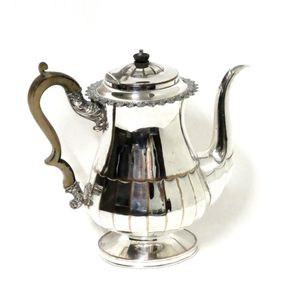Faceted Sheffield Plate Coffee Pot with Boxwood Handle
You must be a subscriber, and be logged in to view price and dealer details.
Subscribe Now to view actual auction price for this item
When you subscribe, you have the option of setting the currency in which to display prices to $Au, $US, $NZ or Stg.
- Boxwood - Boxwood is a hard, yellow coloured, close grained timber. In the 19th century it was often used for inlays, especially stringing, because of its contrasting colour to the darker timbers of the carcase. Stringing is the inlay of a narrow strip of veneer of a lighter colour, such as boxwood along or close to the edges of an object that has been veneered in a darker timber such as mahogany.
Because of its fine grain and resistnce to splitting or chipping it has also been used for treen, turnings, carvings and other small wooden items, such as chess pieces. - Sheffield Plate - Sheffield plate was the first commercially viable method of plating metal with silver. The method of plating was invented by Thomas Boulsover, a Sheffield Cutler, in 1743 and involved sandwiching an ingot of copper between two plates of silver, tightly binding it with wire, heating it in a furnace and then milling it out in to sheet, from which objects could be made.
Originally used by its inventor to make buttons, the potential of the material was quickly realised, and soon it was being used to fashion boxes, salvers and jugs, and not long after that candlesticks and coffee pots, and other traditional tableware.
Although there was a considerable saving in the amount of silver used, Old Sheffield Plate manufacture was more labour intensive than solid silver, meaning higher labour costs. This meant that Old Sheffield Plate was very much a luxury product, and only available to the very wealthy.
The thickness of the silver means that many 18th century Sheffield Plate pieces still have a good layer of silver, while electroplated pieces (EPNS), may have been replated several times over their lifetime. Where the silver has worn off the Sheffield plate the soft glow of the copper base can be seen underneath. However this is not an infallible guide that the piece is Sheffield Plate, as many EPNS items were also plated on to a copper base.
Most Sheffield plate items are unmarked, whereas most elecroplated items display manufacturers names or marks, quality indications such as "A1", "EP", together with pattern or model numbers.
Sheffield plate was made commercially between 1750 and 1850.
This item has been included into following indexes:
Visually similar items

A George III pedestal coffee pot, 1751 London, with maker's mark for Richard Gosling, the tapering tankard form pot with a broad ogee shaped foot rim, having a shaped fruit wood handle with thumb spur, a swan neck spout and stepped dome lid with finial, br

A George II silver coffee pot, fruitwood handle, the base engraved 'Duke of Argyle' which was a slave ship captained by John Newton who later became an Anglican priest and lead the campaign to abolish slavery. London 1742 by George Boothby. Height 26 cm

Russian silver teapot having a tapered neck & round bellied body with ribbed detail. St Petersburg, 1881, maker Ivan Vonifatiyevich Yevstigneyev. Condition: good. Minor wear to the base, slightly loose handle. Height 19.5 cm. Weight 769g

An early Georgian style silver coffee pot, plain tapering cylindrical body raised on a circular spreading foot, domed lid, carved ebony scroll handle, faceted spout. Sheffield 1896 by Mappin Bros. 575gms. Height 24 cm
